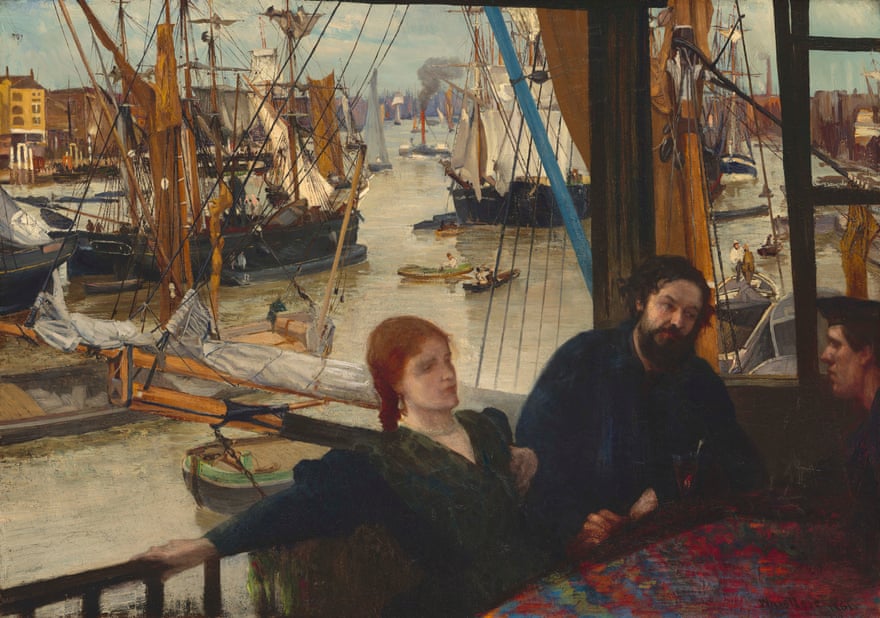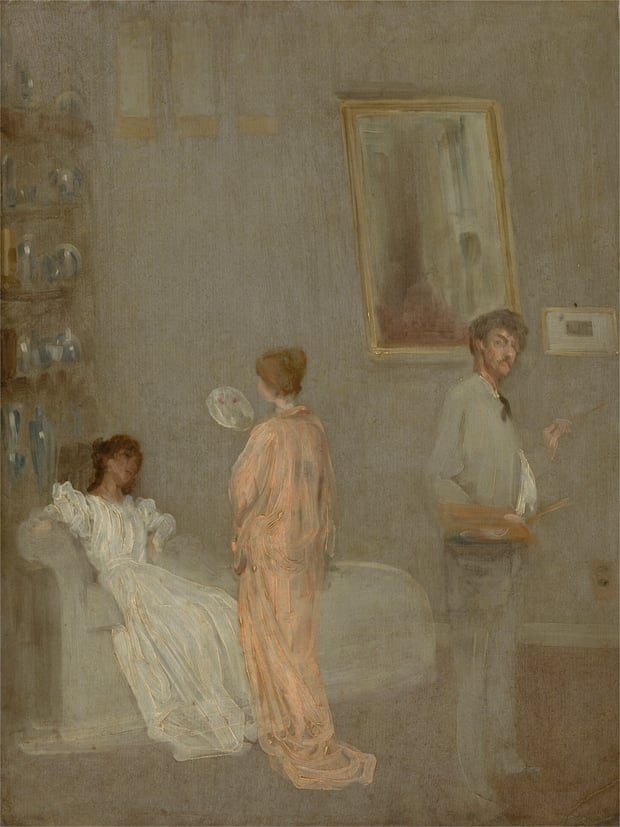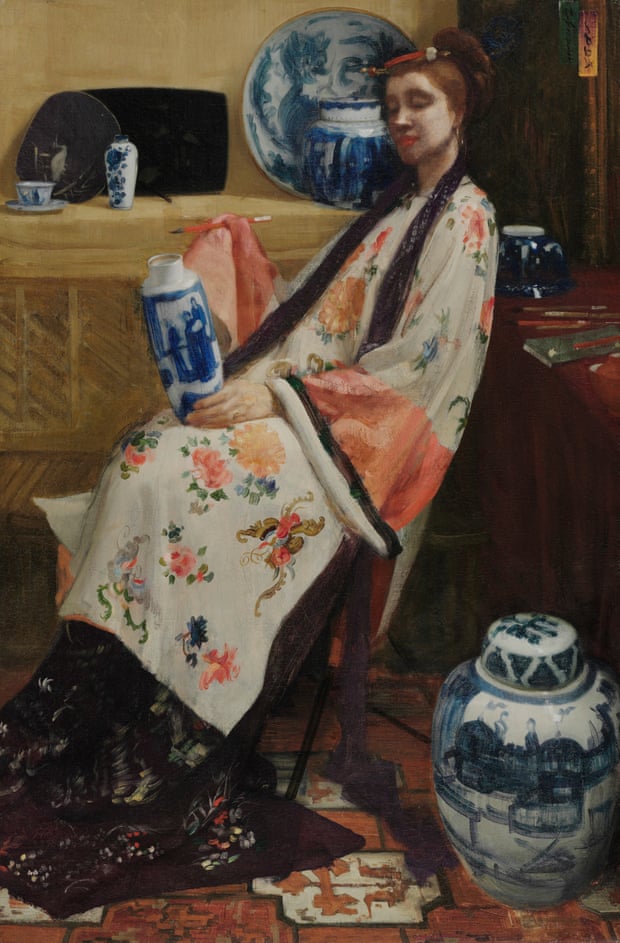Painting Woman in White Dress Stopping a Battle
A merican cowboy James Abbott McNeill Whistler and his flame-haired Irish lover Joanna Hiffernan go on a wild rampage and shoot the art world of Victorian Britain to bits in this hugely enjoyable artistic and biographical romp. It's such a well-told story it will doubtless inspire a so-so film coming to a streaming service near you soon. Don't wait for that; go to the Royal Academy and enjoy a life-affirming adventure with the mothers and fathers of modern art.
To appreciate how new and subversive the double act of Hiffernan and Whistler were in 1860s London you have to realise how clogged Victorian art was. A wall of it suffices to set the airless scene. Dante Gabriel Rossetti's Annunciation is claustrophobic, a narrow picture of a small room where the figures are bled of life in their pseudo-medieval aesthetic prison. Then you look at the opposite wall and a raw, boozy, sexual slice of real life startles you awake.

Whistler's painting Wapping is disorientating. We are in London's docklands in the early 1860s. Charles Dickens had recently published Great Expectations. We picture Victorian London through a Dickensian gothic fog – but Wapping depicts it with harsh yet sensual realism. This is a modern city, where a group of bohemian types hang out at a riverside bar overlooking a grey and green vista of tangled sailing boats and clippers. In the middle of the party, Hiffernan throws back her hair. It's as if she and Whistler think they are in the free and easy world of the Paris avant garde.
That was where Whistler learned to see, when he lived in Paris in the 1850s and got to know such radical observers as Gustave Courbet, Édouard Manet and Charles Baudelaire, whose essay The Painter of Modern Life was published when Whistler was working on Wapping. The creamy palette and ironic accepting eye he brings to a modern moment by the Thames translates the feeling of Manet's masterpieces Le Déjeuner sur l'Herbe and Olympia to London. All the fun of the French is transplanted to the England of Gladstone and Disraeli.
What do we know of Hiffernan outside Whistler's art? Born in Limerick in 1843, she was 17 when she met the dandified artist. She didn't have much formal education but her reading was wide and her opinions astute, said contemporaries: she may have been an aspiring artist as well as model. The three scandalous celebrity paintings Whistler did of Hiffernan wearing a long white dress are all brought together here and they can be seen as a true collaboration. This is modelling as performance art.

The pure white dress, you see, is a joke. There's nothing virginal about Hiffernan in Whistler's 1862 icon Symphony in White, No 1. She stands above you confidently, and Whistler makes the supposedly modest dress suggest her nakedness underneath. That's because she is standing on a bearskin rug whose soft fur leads your eyes to the rim of the dress, to picture her naked feet nestling in it – a traditional image of sensuality in sculpture that goes back to Renaissance images of the triumphant David with his foot in Goliath's hair.
The painting's first audience may not have been prepared to imagine this but were sufficiently shocked by Hiffernan's loose red hair and relaxed manner. It flaunts a love all too ready to speak its name. Whistler wittily parodies the pre-Raphaelites with their "muses" and fetishistic allusions to repressed desire. He might as well have written on the canvas: "I'm sleeping with her."

The second Symphony in White shows her in a double image: she poses elegantly against a fireplace like a living decoration for the stylish bourgeois home – Japanese fan and all – yet we see her face, turned from us, meditating ambiguously in the mantlepiece mirror. This is a deepening effect Whistler gets from Velázquez's Rokeby Venus. Whistler and Hiffernan set out for Madrid to study Velázquez together but got distracted when they found a love nest in the Pyrenees.
Whistler watches Hiffernan naked in the studio in an unfinished scene. He shows her sleeping, and contemplating glistening Chinese porcelain while posing in a kimono. He imagines her as a woman from the "floating world". His mother – as in Whistler's Mother – urged him to make an "honest woman" of Hiffernan: his response was not to marry but to make a will in which he left her everything.
In the event she died before him, in her mid-40s in 1886. The story this show tells, however, climaxes at Trouville in Normandy where they stayed with Courbet in autumn 1865. Eating seafood in a half-empty hotel, painting on the beach, listening to Hiffernan sing Irish songs at twilight – Courbet remembered it as a romantic time. This part of the story really would make a great little film, if François Truffaut was still around to direct it.

Courbet painted Hiffernan, too. He kept the original with him always, painting replicas to sell. But which of the three versions on show is his treasured possession? It has to be Jo, the Beautiful Irish Girl from the Nationalmuseum, Stockholm, with its nostalgic passion. There are rumours it all went further: that Hiffernan might even have been the model for Courbet's outrageous painting The Origin of the World. But the curators haven't found any evidence that she was in Paris. Besides, Courbet was struck by her red hair. As a ginger, I can point out that she would also have had red pubic hair, which the model for The Origin of the World didn't.
In fact, the Jo Hiffernan who haunts this exhibition is never objectified, never a piece of artist's meat. It's a surprisingly tender love story that also brings to life one of the most revolutionary moments in the story of art, when cobwebs of hypocrisy and pretension were swept away by life itself.
-
Whistler's Woman in White: Joanna Hiffernan is at the Royal Academy, London, 26 February to 22 May
Source: https://www.theguardian.com/artanddesign/2022/feb/23/whistlers-woman-in-white-joanna-hiffernan-raw-boozy-sexual-slices-of-real-life-and-love
0 Response to "Painting Woman in White Dress Stopping a Battle"
Post a Comment